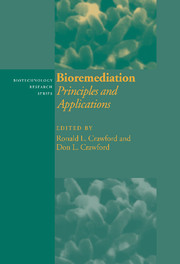Book contents
- Frontmatter
- Contents
- List of contributors
- Preface
- Introduction
- 1 Engineering of bioremediation processes: needs and limitations
- 2 Bioremediation in soil: influence of soil properties on organic contaminants and bacteria
- 3 Biodegradation of ‘BTEX’ hydrocarbons under anaerobic conditions
- 4 Bioremediation of petroleum contamination
- 5 Bioremediation of environments contaminated by polycyclic aromatic hydrocarbons
- 6 Bioremediation of nitroaromatic compounds
- 7 A history of PCB biodegradation
- 8 Bioremediation of chlorinated phenols
- 9 Biodegradation of chlorinated aliphatic compounds
- 10 Microbial remediation of metals
- 11 Molecular techniques in bioremediation
- Index
Introduction
Published online by Cambridge University Press: 28 October 2009
- Frontmatter
- Contents
- List of contributors
- Preface
- Introduction
- 1 Engineering of bioremediation processes: needs and limitations
- 2 Bioremediation in soil: influence of soil properties on organic contaminants and bacteria
- 3 Biodegradation of ‘BTEX’ hydrocarbons under anaerobic conditions
- 4 Bioremediation of petroleum contamination
- 5 Bioremediation of environments contaminated by polycyclic aromatic hydrocarbons
- 6 Bioremediation of nitroaromatic compounds
- 7 A history of PCB biodegradation
- 8 Bioremediation of chlorinated phenols
- 9 Biodegradation of chlorinated aliphatic compounds
- 10 Microbial remediation of metals
- 11 Molecular techniques in bioremediation
- Index
Summary
Most organic chemicals and many inorganic ones are subject to enzymatic attack through the activities of living organisms. Most of modern society's environmental pollutants are included among these chemicals, and the actions of enzymes on them are usually lumped under the term biodegradation. However, biodegradation can encompass many processes with drastically differing outcomes and consequences. For example, a xenobiotic pollutant might be mineralized, that is, converted to completely oxidized products like carbon dioxide, transformed to another compound that may be toxic or nontoxic, accumulated within an organism, or polymerized or otherwise bound to natural materials in soils, sediments, or waters. More than one of these processes may occur for a single pollutant at the same time. The chapters in this book will discuss these phenomena in relation to specific groups of xenobiotic pollutants, since these processes ultimately determine the success or failure of bioremediation technologies.
Bioremediation refers to the productive use of biodegradative processes to remove or detoxify pollutants that have found their way into the environment and threaten public health, usually as contaminants of soil, water, or sediments. Though biodegradation of wastes is a centuries-old technology, it is only in recent decades that serious attempts have been made to harness nature's biodegradative capabilities with the goal of large-scale technological applications for effective and affordable environmental restoration. This development has required a combination of basic laboratory research to identify and characterize promising biological processes, pilot-scale development and testing of new bioremediation technologies, their acceptance by regulators and the public, and, ultimately, field application of these processes to confirm that they are effective, safe, and predictable.
- Type
- Chapter
- Information
- BioremediationPrinciples and Applications, pp. 1 - 12Publisher: Cambridge University PressPrint publication year: 1996
- 2
- Cited by



